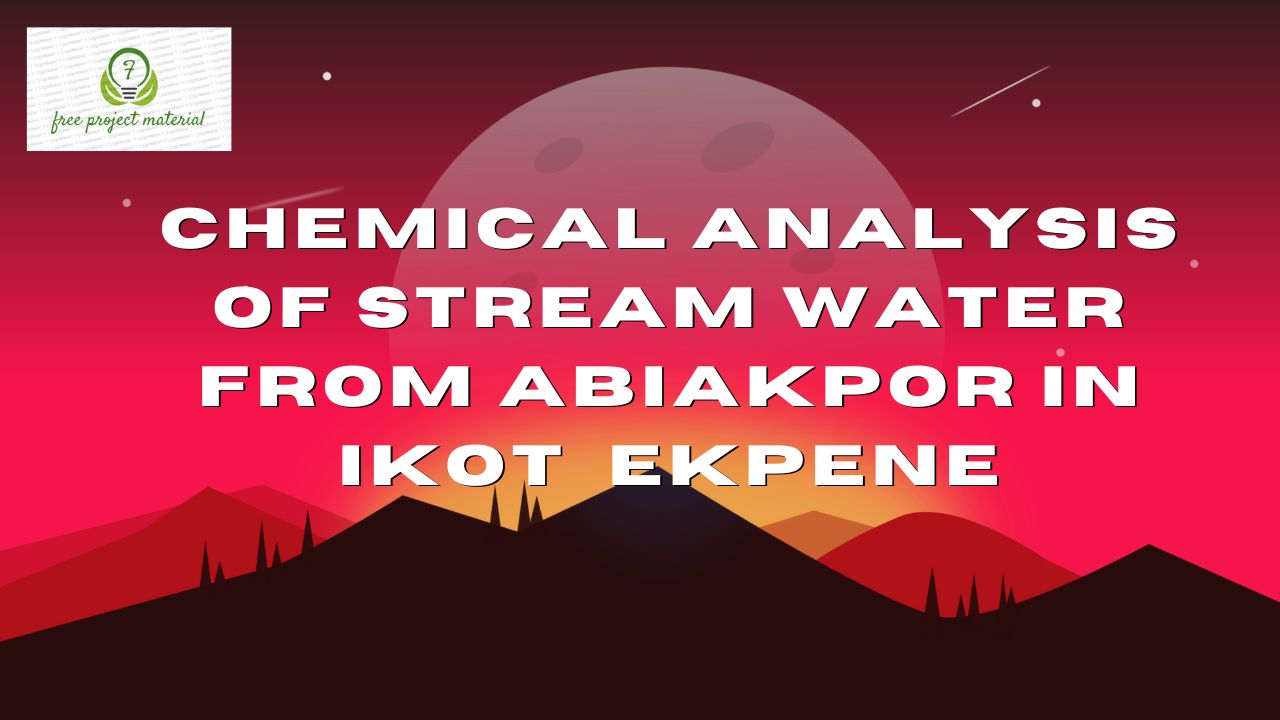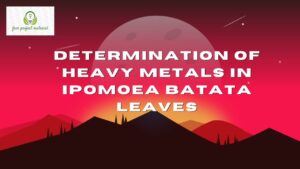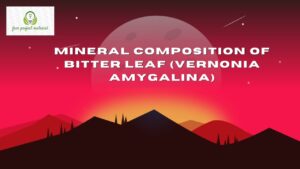ABSTRACT
The analysis for the chemical composition of water obtained from Abiakpo in Ikot Ekpene was carried out using standard analytical method. The result of the analysis was as follows; alkalinity (32.998±0.006), Titrable acidity (50.892±0.112), Dissolved oxygen (8.295±0.413), biochemical oxygen demand (3.371±0.043), sulphate ion (2.36±0.453) nitrate for (6.415±0.262), phosphate ion (13.601±0.281) comparing the result with world Heath Organization standard (WHO) all the chemical parameters investigated were within the permissible limit stipulated by the above agency except Phosphate. However, regular monitoring and assessment is advocated to prevent future pollution.
TABLE OF CONTENTS
Title page- – – – – – – – – – i
Certification – – – – – – – – – ii
Dedication- – – – – – – – – – iii
Acknowledgement- – – – – – – – iv
Abstract- – – – – – – – – – v
Table of contents- – – – – – – – vi-xi
CHAPTER ONE
1.0 Introduction- – – – – – – – 1-3
1.1 Aim and objectives of the study- – – – – 3-4
1.2 Scope and limitation- – – – – – – 4
1.3 Definition of the study- – – – – – – 4
CHAPTER TWO
2.0 Literature review- – – – – – – – 5
2.1 Review of Related Literature- – – – – – 5-7
2.2 The chemistry of water- – – – – – – 7
2.3 Occurrence of water- – – – – – – 8-9
2.4 Effects of water on life- – – – – – – 9-11
2.5 Chemical properties of water- – – – – – 11-14
2.6 PH- – – – – – – – – – 14-15
2.6.1 Electrical conductivity (EC)- – – – – – 15
2.6.2 Alkalinity- – – – – – – – – 15-16
2.6.3 Sulphate- – – – – – – – – 16
2.6.4 Bicarbonate- – – – – – – – 17
2.6.5 Biochemical oxygen Demand (BOD)- – – – – 17
2.6.6 Chemical Oxygen Demand (COD)- – – – – 17-18
2.6.7 Chloride- – – – – – – – – 18
2.7 Water Quality Index- – – – – – – 18-19
CHAPTER THREE
3.0 Materials and Methods- – – – – – – 20
3.1 Materials and Reagents- – – – – – – 20-21
3.2 Sample Collection- – – – – – – 21
3.3 Sample preparation- – – – – – – 21
3.3.1 Determination of Biological Oxygen (BOD) (Isaac, 2000)- 21
3.3.2 Determination of Nitrate content (NO3)(Steffen, 2007)- – 21-22
3.3.3 Determination of Dissolved Oxygen (Gupta, 2009)- – 22-23
3.3.4 Determination of sulphate (SO4-2)(Isaac, 2000)- – – 23
3.3.5 Determination of Alkanity (Kotz, 2005)- – – – 24
CHAPTER FOUR
4.0 Result and Discussion- – – – – – – 25
4.1 Result – – – – – – – – – 25
4.2 Discussion- – – – – – – – – 26-29
CHAPTER FIVE
5.0 CONCLUSION AND RECOMMENDATION- – – 30
5.1 Conclusion- – – – – – – – – 30
5.2 Recommendations- – – – – – – 31
References
CHAPTER ONE
1.0 INTRODUCTION
Water is one of the most important and abundant compound of the ecosystem. All living organism on the earth need water for their survival and growth. As of now only earth is the planet having about 70% of water. But due to human population, industrialization, use of fertilizers in the agriculture and man –made activity it is highly polluted with different harmful contaminants. Therefore it is necessary that the quality of drinking water should be checked at regular time interval, because of the use of contaminated drinking water, human population suffers from various forms of water borne diseases. It is difficult to understand the biological phenomenon fully because the chemistry of water revels much about the metabolism of the ecosystem and explain the general hydro-biological relationship (Basavaraja simpi et al., 2011). Water is the most valuable natural resource available to man, without which no life can survive. Therefore, adequate and safe water supply is a pre-requisite for significant socio-economic development of any community (Algaon-idot et al., 2012). Water bodies pollution is the introduction of contaminants into water bodies. Water pollutants are directly or indirectly discharged into water bodies without adequate treatment to remove harmful substances (Diersong, 2009). Water pollution affects plant and animals living in these water bodies, and also, affect , other aquatic biota. Globally, the most prevalent water quality problem is eutrophication the introduction of nutrients (mainly phosphates and nitrates) Into water bodies. Eutrophication substantially impairs beneficial uses of water (Moss, 1972).Water is essentially for the survival of all forms of life and the availability of good quality water is an indispensable feature for presenting diseases and improving the quality of human life. Rivers play a major role integrating and shaping the landscape and molding the ecological setting of a basin. They are key in controlling the global water circle and are the most dynamic agents of transport in the hydrological circle. Water resources are importance for human life and economy are the main source to fulfill drinking water needs, irrigation of lands and for industry. Therefore lack of water is considered as socio-economic obstructive factor of a country.
Rivers are the most important fresh water source for humans. The social, economic and political developments, in the past, were largely related to the availability and distribution of fresh water contained in river system. The use of river water includes drinking water supply sources, irrigation of agriculture land, industrial and municipal water supply, industrial and municipal waste disposal, navigation, fishery, recreational boating and recreation (Frarizin, 1972).
1.1 Aim and Objectives of the study
The aim of this research work is to analyse chemical parameters of stream water from Abiakpo in Ikot Ekpene. This would be adhered through the following objectives;
- To compare the quality of this water with the standard and other research work for further studies.
- To make useful recommendations based on the results of this research.
- To determine some chemical parameters in stream water from Abiakpo in Ikot Ekpene.
1.2 Scope and limitation
This research focuses on the chemical analysis of stream water and was only limited to Abiakpor stream due to financial constraint and limited time.
1.3 Definition of terms
WATER
Water is a transparent, tasteless, odourless, and nearly colourless chemical substance, which is the main constituent of earth’s stream lakes, ocean and the fluid of must living organism.
STREAM
A body of water with surface water flowing within the bed and banks of a channels.


